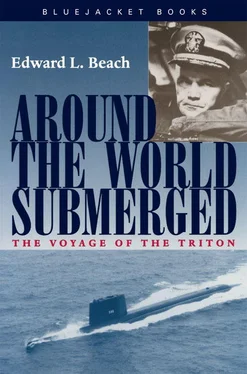The gaily dressed crowd on the ground below spread out in all directions, spilled over the temporary barriers erected by Electric Boat, crowded on top of the stacked lumber and building materials on both sides. Some of them even stood on the roofs of nearby buildings. As I watched, I was amused to see an Electric Boat officer climb to the top of one of the buildings and chase away a number of teen-agers. Most of the uniforms were whites, the prescribed attire for the occasion. There were sailors from other ships acting as ushers; a sprinkling of blue and gray-green-uniformed police officers scattered about, preserving order. Nearly half the crowd were women; and there were a number of children about, too, most of them clutching the hands of their parents. One or two of the smaller tots perched on the shoulders of a uniformed father, and a few raced around in games of tag or follow-the-leader.
My own children were somewhere in the crowd, I knew, but I searched for them without success. They were supposed to be up near the launching platform in the care of a secretary of Electric Boat, for Ingrid, my wife, could not be here. She was in Boston with her father, whose postoperative condition had suddenly become critical.
Excited, high-pitched chatter wafted up to me, but soon the crowd grew silent, and I heard the loudspeakers rumble with the voice of one of the presiding dignitaries. Not a word of what was being said could be distinguished, but from the timetable I had studied that morning, I knew that Admiral Jerauld Wright, Commander in Chief of the United States Atlantic Fleet and Supreme Allied Commander, Atlantic, was about to deliver the principal address. After Admiral Wright finished, there would be an invocation, and then Triton would be christened by Louise Will, wife of Vice-Admiral John Will, USN (ret.), with the traditional shattering of a bottle of champagne. Then, at long last, the trigger holding the launching cradle would be released, and we would slide backward into the water.
There was a scattering of applause from below, then silence again. The drone of the loudspeakers went on and off several times. Some people near the invisible launching platform bowed their heads. Still not an intelligible word came through the loudspeakers, and I could only assume that the launching was drawing closer. Instinctively, I took a firmer grip on the handrail.
There is always a little apprehension when a ship is launched. Will she start when the trigger is released? Will the motion be accompanied by a jolt which might knock personnel off their feet or over the side? Poised only on two slender slides for her entry into water, our ship was in its most vulnerable condition. Any miscalculation, any error in fixing the location of the stresses, could easily result in damage. Unthinkable, but conceivable—she might even topple over. Surface ships, usually broader than they are tall and essentially flat-bottomed, are not prone to such mishaps, but submarines are taller than they are wide and their bottoms are round. The catastrophe of rolling over on the crowds below would be appalling. A fine time for me to come up with this, I thought; surely the Electric Boat people ought to know how to launch a submarine, even one as big as Triton.
Being idle, I also had time to concern myself over how the new ship would behave when she entered the water. Were the many hull openings all closed? Submarines are designed to lie low in the water. Might Triton not partially submerge as she entered her element? It had happened before.
The speakers went off again. There was a moment’s interruption, then the blare of a steam whistle and a siren, joined immediately by several others. I felt nothing: no tremor, no shift of weight, no indication of motion—nothing. And then the steel General Dynamics sign on the structure of one of the crane tracks began to glide away. For a long moment I watched it, wondering whether it was really moving or whether it was simply that I wanted it to move. But the sign was actually receding, and within seconds, the vertical stanchions that lined the building ways were flying by.
I turned around just in time to see our stern enter the water with a great froth of white spray, as the propellers dug in. An insignificant amount of water came up over the turtle back and part of the main deck aft—not far. On either side of us, long streamers of white wake marked our dash. And now we were in the river; small boats and pleasure craft of all sorts, heretofore maintaining a cautious distance, raced toward us for a closer look. Up ahead was water, and the naked ways. Triton was fully waterborne.
In reporting the ceremony and the launching, the New London Day commented that as she slid down the ways, Triton attained a speed higher than she would ever see again. Having spent the past seven months studying the power-packed ship, I had some reservations about the accuracy of that statement.
After launching, there is a long period of further construction, called “fitting out”—a holdover from traditions of the days of sail when “fitting out” amounted to installing masts and guns in a completed hull. It is not the launching, but the commissioning of a ship which signifies her acceptance for service. And, although launched on the nineteenth of August, 1958, Triton did not go to sea on trials until September, 1959. She was commissioned into the Naval Service on the tenth of November, 1959.
This period between launching and commissioning is critically important, for this is when the bulk of the crew is assembled and organized into a cohesive ship’s company. In forming a crew, nuclear ships have a special advantage, thanks to Admiral Rickover’s foresight. All our engineering personnel came directly from the Triton ’s prototype at West Milton, New York, where they had been put through a rigorous training schedule on the dry-land reactor and engine room the Atomic Energy Commission had built there at the Admiral’s behest. These men were already thoroughly trained and qualified in their primary functions. Nuclear ships are unique—and among the special aspects was that our engineering department, in effect, was handed to us ready-made. Its personnel could not have been better prepared for their duties. Proper preparation to take the ship to sea would have been impossible otherwise.
Some of the men came from other submarines, but most of them were in no way connected with the propulsion plant. One, Chester Raymond Fitzjarrald, a Chief Torpedoman’s Mate with some eighteen years service, had last been in my old ship, Trigger II, where he had held the position of Chief of the Boat. (In submarines, the “Chief of the Boat” is the key enlisted man, direct assistant to the Executive Officer.) Fitzjarrald was a natural for this post, and was so assigned in Triton. In deference to her size, we promoted him a notch and made him “Chief of the Ship.”
Another old shipmate who had been Chief Fire Controlman in Trigger II, Loyd L. Garlock, was given a similar job in Triton. A third, William E. Constantine, had been in the Amberjack in 1948 and ’49.
It was heartening to have these old friends serving with me, but it was not any of my doing; the Navy cannot operate with favoritism and personal interest. The submarine force is so small (it represents only three percent of the entire US Navy—approximately the same size as the WAVES) that after a few years, one may have served with almost everyone in the force at one time or another.
I did assert myself in one case, however: Lawrence W. Beckhaus, the Gunner’s Mate who had dived from Salamonie’ s deck into fifty-foot waves to rescue a man swept overboard from another ship, had since become a submariner. He also reported aboard.
Читать дальше












